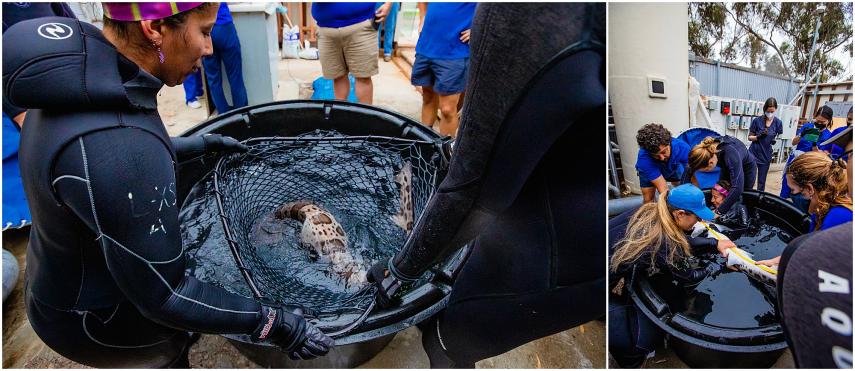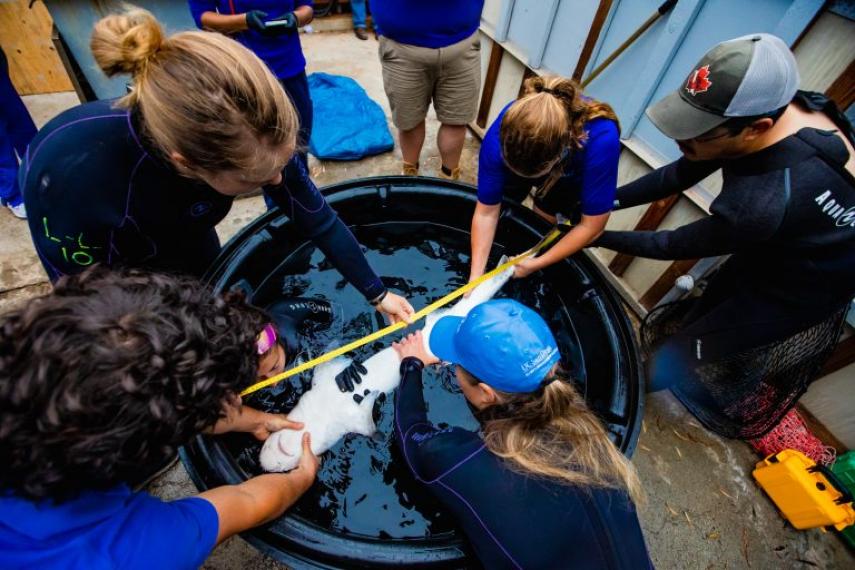Just like you need to go to the doctor for your yearly checkup … so do our Leopard Sharks! From head to tail and everything in between, our husbandry team works hard to ensure that our sharks are in tip top shape. Recently, our Leopard Sharks underwent a routine checkup — let’s dive in and see what goes into Leopard Shark care at Birch Aquarium at Scripps!
How do we differentiate our Leopard Sharks?
If you’ve ever ventured out to Shark Shores you may have noticed we have several Leopard Sharks swimming about — you can also spot this species in our Giant Kelp Forest. These local sharks certainly stand out thanks to their iconic saddle-shaped splotches all along their upper body and fins. Just like we have unique fingerprints, Leopard Sharks have a unique pattern — our aquarists are able to tell our Leopard Sharks apart based on their coloration and patterns!
So … how do you move a shark?
Leopard Sharks are known for their stealth and speed and can get upwards of 7 feet long — so moving them from Shark Shores to our examination pool can come with its own set of challenges! Before our husbandry team begins the checkup, they’ll discuss their plan in depth. It’s important to make sure everyone knows exactly what they need to do. This communication ensures that our shark checkup runs quickly and smoothly.
All geared up and ready to go, a few aquarists enter the water donned in scuba gear — their goal is to catch our sharks, one at a time. While it might seem like a simple task, it takes a unique skill set to snag a shark — one that involves stealth, speed, and of course a large specialized net!

Success! Once a shark is caught, our husbandry team works as a unit to cradle the shark in the mesh net and safely lower it to a separate pool. We’ll briefly roll our sharks upside down and put them in tonic immobility, a technique that puts our sharks in a calm, resting state. It allows our husbandry team to get up close and personal with the shark, without adding stress to the animal or our staff.

What do we learn about our Leopard Sharks?
During this routine checkup, our aquarists start by measuring their total weight, length, and girth of each individual Leopard Shark. Next, we’ll examine our shark’s individual features like their eyes, gills, fins and even skin!

Gills
Most sharks, including Leopard Sharks, have 5 gill slits on each side of their body. Gills are a shark’s respiratory organ — for us humans, it’s our lungs! Our aquarists examine each individual gill slit to confirm everything looks healthy.
Fins
Sharks use their fins to steer and swim, but each particular fin has its own unique purpose! Sharks use their caudal fin (tail) to swim — they’re able to generate power by moving this find from side to side. Their pectoral fins are used to steer and are found on their sides. Finally, their dorsal fin is used for stabilization and is located at the very top of their body! Our aquarists will examine each fin to make sure nothing looks out of the ordinary.
Skin
Sharks also pretty unique skin! If you’ve ever had the chance to touch a shark out at Preuss Tide Pool Plaza, you may have observed that our sharks have fairly rough skin. Sharks are covered in tiny, flat pointed scales called dermal denticles — aka “skin teeth.” These denticles decrease drag, allowing sharks to swim fast and efficiently. Our aquarists will take a closer look at their skin to ensure that no abnormalities are present.
Bloodwork
Our veterinarians even collect blood samples during these exams. Analyzing their bloodwork helps us better understand the overall health of our Leopard Sharks. We’re able to track their nutrition and figure out if any adjustments need to be made to their diet. This incredible team effort was a major success — each one of our sharks got a clean bill of health and were safely placed back into Shark Shores.

What else can be found in Shark Shores?
Shark Shores is home to a few other local species you can find all along the coast of Southern California. These include Smoothhound Shark, Bat Rays, Halibut, and even critically endangered Pacific Angel Sharks!
Remember! Sharks are vital to maintaining healthy ocean ecosystems worldwide. From the local Leopard Sharks that swim in the shallows of La Jolla Shores to the reef sharks that cruise among coral reefs, and to those that dive to the deepest depths of our ocean, every shark is important and helps our ocean thrive. This Shark Week join us as we celebrate these jaw-some creatures and highlight all the reasons why sharks are RAD, not bad!